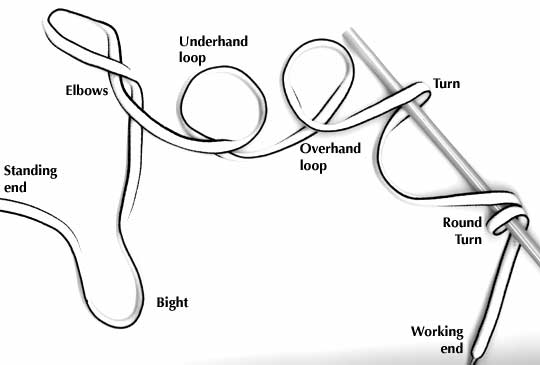Basics: Cord Anatomy
 Interrupting our ongoing discourse on good luck knots, I’m going back to basics with an illustration of terms used to describe various cord parts and configurations.
Interrupting our ongoing discourse on good luck knots, I’m going back to basics with an illustration of terms used to describe various cord parts and configurations.
In this definition I have tried to be as formal and precise as possible. Alas that I can’t really maintain that level of precision in the rest of my writings. In particular I use “loop” altogether too often…
- Standing End, Fixed End, or Bitter End
- the end of the cord that receives the least amount of manipulation, perhaps it is heavily embellished or perhaps it is fixed to something.
- Working End, Running End, or Live End
- the end of the cord that is actively involved in making the knot or interlacing
- Standing Part
- part of the cord between the knot and the standing end
- Working Part
- part of the cord between the knot and the working end
- Working Length
- the amount of cord required to comfortably tie a knot versus the amount of cord required by the tied knot can vary greatly. The working length is the amount of cord required to tie the knot.
- Bight
- an open loop, a curved section in the cord that does not cross itself
- Tied in the Bight
- tying a knot by folding the cord and using a bight as the working end
- Elbows
- two cord segments that cross at two points
- Underhand Loop
- a closed loop where the working end passes under the standing part
- Overhand Loop
- a closed loop where the working end passes over the standing part
- Turn
- where the cord folds over or passes through an object
- Round Turn
- where the cord encircles an object, sometimes called two turns.
- Double x knot
- a larger version of the x knot, it's next logical progression. Where applicable, there can be triple, quadruple, quintuple, etc.
- Doubled x knot
- running a parallel line through knot x to add a decorative element. Similarly the knot x can be tripled, quadrupled, quintupled, etc.